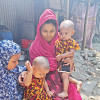Bangladesh has highest prevalence of child marriage in South Asia: Unicef

Despite significant progress in recent years, Bangladesh has the highest prevalence of child marriage in South Asia and ranks among 10 countries in the world with the highest levels, said Unicef today.
A new Unicef report calls for accelerated action to end child marriage in Bangladesh by 2030.
The report "Ending Child Marriage: A Profile of Progress in Bangladesh" was launched on Wednesday at a virtual event which was attended by representatives from the UN, the government, development partners and adolescent clubs.
Ending child marriage is a priority for both the Government of Bangladesh and Unicef.
However, to achieve the Sustainable Development Goal (SDG) target to end child marriage by 2030, and the national target to end child marriage by 2041, Bangladesh requires more efforts to bring change.
Progress must be at least 8 times faster than the rate of the past decade to meet the national target, and 17 times faster to meet the SDG target.
"Together we must challenge harmful norms and end child marriage. This human rights violation has devastating consequences for individuals and societies, robbing children of their childhoods and limiting their life choices. We must invest now to secure girls' rights to life and education, and reduce their exposure to violence and exploitation," said Veera Mendonca, Unicef Deputy Representative in Bangladesh.
While the prevalence of child marriage in Bangladesh has dropped from over 90 per cent in 1970, it remains very high: 51 percent women who are currently aged 20-24 were married while they were still children.
As a result, the country is home to 38 million child brides who were married before their 18th birthday, including 13 million who married before the age of 15.
The ongoing Covid-19 pandemic now threatens to roll back progress on ending child marriage.
As children and families cope with school closures, loss of income and increased pressure in the home, there are heightened risks of child marriage.
This is one of the reasons why Unicef is urging governments globally to prioritise the safe re-opening of schools. Even during normal times married girls are over four times more likely to be out of school than unmarried girls.
"Girls must be encouraged to return to education to advance their knowledge and skills," said Dr Abul Hossain, deputy secretary, project director, Multi-Sectoral Programme to End Violence Against Women, Ministry of Women and Children Affairs.
He said those with an education beyond secondary school are least likely to be child brides, even if they are from poorer households and live in rural areas. "Education is our greatest tool to transform society and bring equal opportunities for girls."

 For all latest news, follow The Daily Star's Google News channel.
For all latest news, follow The Daily Star's Google News channel. 








Comments